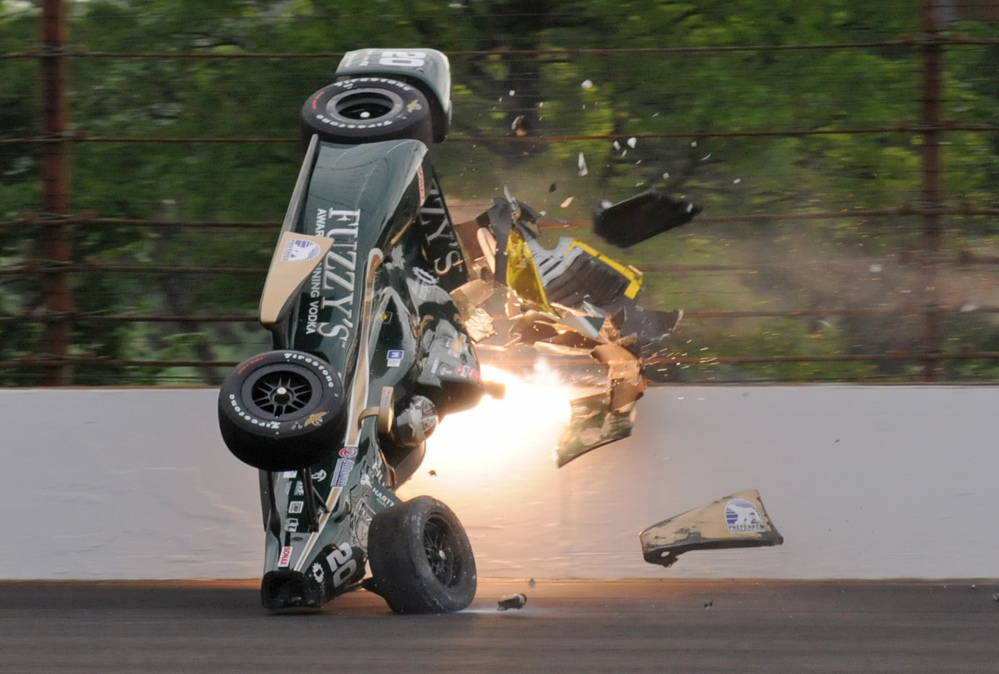Justin Wilson. Dan Wheldon. Paul Dana.
Dead.
Tony Renna. Greg Moore. Scott Brayton.
Dead.
Alex Zanardi. Sam Schmidt. Davey Hamilton.
Maimed for life.
Dario Franchitti. Cristiano da Matta. Kenny Brack.
Forced to retire.
James Hinchcliffe. Mikhail Aleshin. Mike Conway.
Lucky to be alive.
Enough already. After the latest tragedy in IndyCar — Wilson’s death from being struck on the top of the head by a piece of flying debris during a race last weekend at Pocono — it’s time to shut down this ridiculously dangerous form of racing.
The IndyCar series is already on its last legs, plagued by poor attendance and minuscule television ratings.
But forget economics.
This is about doing what’s right to prevent anyone else from meeting an untimely end.
Pray that everyone survives Sunday’s season-ending race at Sonoma, then pull the plug.
It’s already too late to undo the tragedy and mayhem of the last two decades. Going back to 1996, eight drivers, six fans, and one track official have been killed at IndyCar events, either in the current series or its predecessors, the Indy Racing League and CART-Champ Car.
One death is too many, but compared to two other major series, Formula One and NASCAR, IndyCar’s mortality rate is simply unacceptable.
And it goes beyond those who paid the ultimate price. IndyCar has endured scores of serious injuries and life-changing wrecks — again, far more than those other series.
Zanardi had both legs ripped off in a crash. Schmidt is a quadriplegic. Hamilton underwent some two dozen surgeries after his feet were crushed. Franchitti, da Matta and Brack all survived horrific crashes but their careers were essentially over. Hinchcliffe hasn’t gotten behind the wheel since a wreck nearly took his life while practicing for this year’s Indy 500. Aleshin will finally return to the track this week at Sonoma, a year after he was critically injured in the 2014 finale at Fontana. Conway still races but wisely refuses to compete on ovals after a huge crash at Indianapolis.
“When you have a sport where you put on helmets and firesuits, obviously it’s not safe,” said Hamilton, who became a car owner and radio commentator after his devastating wreck at Texas Motor Speedway in 2001. “The last time I checked, you don’t see Tiger Woods putting on a helmet and a firesuit.”
That said, Hamilton isn’t calling for the sport to be shut down. He loves IndyCar racing too much to even consider that an option.
But it’s highly doubtful that IndyCar’s supposed leadership, wracked for years by dissension and poor decision-making, can figure things out.
Take the current rules package, which gives the cars excessive downforce and strips them of horsepower, leading to three- and four-wide racing at some oval tracks. Hamilton believes this is just another disaster waiting to happen.
“Right now, it’s too much of a bravery test,” he said. “You just go wide open around the track and it’s a matter of who’s the bravest and who can get the closest to each other. I don’t believe in that kind of racing.”
Clearly, Formula One and NASCAR have come up with packages that are much safer.
When Jules Bianchi died in July, nine months after suffering severe head injuries in a wreck at the Japanese Grand Prix, he was the first Formula One fatality since Ayrton Senna in 1994. NASCAR hasn’t lost anyone since Dale Earnhardt’s last-lap wreck in the 2001 Daytona 500, a jarring wake-up call that led to improved protection for the head and neck, concrete walls being cushioned with padding, and a much sturdier race car.
Wilson’s death sparked calls for IndyCar to add some sort of canopy to protect the cockpit, where the driver’s head is exposed to the elements. But is it even possible to reach an acceptable level of safety — especially on the oval circuits, with open-wheel missiles darting around the track at more than 200 mph?
At the very least, IndyCar should totally abandon its oval events, which are already an endangered species on the schedule. Just six of 16 races this year were held on the high-speed tracks, and it’s very possible the series could have only two or three oval races next year. Not surprisingly, most of the worst wrecks over the last 20 years have occurred on ovals. A road-racing series would surely be safer than what they have now.
But what about the most famous race in the series, the Indianapolis 500, held in May on a 2.5-mile oval?
This will sound like heresy to the purists, but the Indy 500 could become an event on the NASCAR Sprint Cup schedule, replacing the Brickyard 400 in late July. True, the racing in the Brickyard has been downright boring, leading to declining attendance and calls for the track to be dropped altogether. But a tedious NASCAR race would be an improvement on the carnage from this past May, when Hinchcliffe was injured and three other Indy cars flipped during practice sessions.
Such a move also would require the stock-car series to shift one of its biggest events — the Memorial Day weekend race at Charlotte, on the same day as the 500 — to a different date, a monumental change sure to ruffle the traditionalists even more.
But they’d get over it, just as they eventually got over the abandonment of long-time NASCAR tracks such as Rockingham and North Wilkesboro.
Those of us who are big IndyCar fans would get over it, too.
It’s time to end a sport that has destroyed too many lives.
Send questions/comments to the editors.



Comments are no longer available on this story